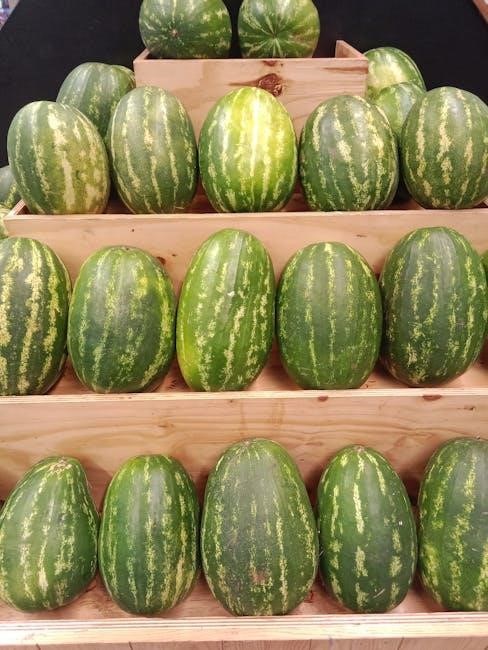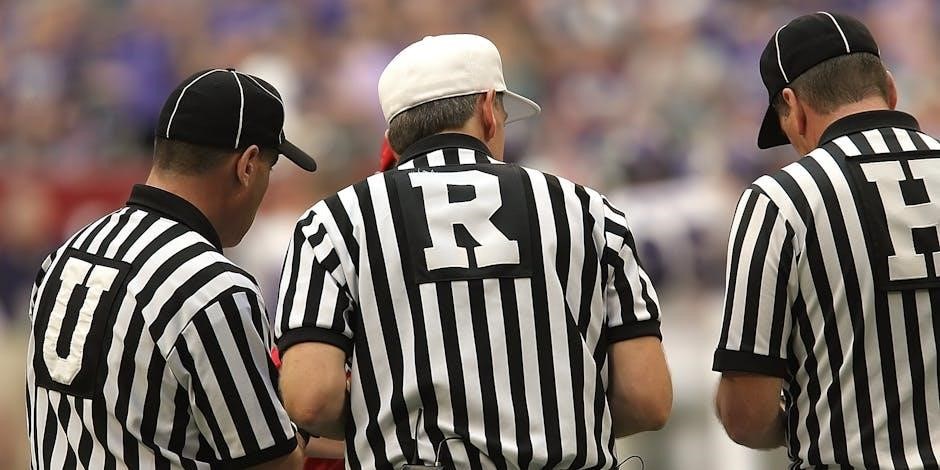Maine’s 2024 striped bass regulations ensure responsible fishing practices, balancing recreational and commercial interests while promoting conservation. Key components include permits, size limits, and gear restrictions to sustain the fishery.
1.1 Overview of Striped Bass Fishing in Maine
Striped bass fishing in Maine is a popular recreational and commercial activity, attracting anglers due to its abundant coastal waters. The fishery is managed to ensure sustainability, balancing catch limits and gear restrictions. Recreational anglers must obtain permits, while commercial operations require specific licenses. Size limits, such as minimum and maximum lengths, are enforced to protect juvenile and breeding fish. Maine’s regulations aim to preserve the striped bass population while supporting both recreational and commercial interests. Conservation efforts are central to maintaining this valuable resource.
1.2 Importance of Adhering to Regulations
Adhering to Maine’s striped bass regulations is crucial for maintaining a healthy fish population and ensuring the long-term sustainability of the fishery. Compliance with permits, size limits, and gear restrictions helps protect juvenile fish and breeding stocks. Violations can lead to penalties, harming both the environment and the fishing community. By following the rules, anglers contribute to conservation efforts and preserve the striped bass fishery for future generations. Responsible fishing practices are essential for balancing recreational and commercial interests with ecological preservation.
Recreational Saltwater Fishing Permits
A recreational saltwater fishing permit is required for anglers targeting striped bass in Maine, ensuring compliance with state regulations for personal use.
2.1 Requirements for Recreational Anglers
Recreational anglers in Maine must obtain a saltwater fishing permit to target striped bass. The permit ensures compliance with state regulations, including size limits and gear restrictions; Anglers must adhere to a minimum size limit of 28 inches and a maximum of 31 inches for striped bass. Fish caught under this permit are for personal consumption only. Additionally, anglers must use hook-and-line gear exclusively, with no gaffing allowed. Bait is prohibited when using treble hooks, ensuring sustainable and responsible fishing practices.
2.2 How to Obtain a Recreational Permit
To obtain a recreational permit for striped bass fishing in Maine in 2024, visit the Maine Department of Marine Resources (DMR) official website. Navigate to the recreational permits section and follow the online application process. Create an account if needed, and provide required personal and residency information. Pay the applicable fee, if any, and review the terms and conditions before submitting. Permits may also be available at local tackle shops for convenience. Ensure to check for any age restrictions or requirements for minors. The process is designed to be straightforward, allowing anglers to secure their permits efficiently before the fishing season begins.
Commercial Striped Bass Fishing Regulations
Commercial striped bass fishing in Maine requires specific permits, with eligibility based on historical landing data. Catch limits are strictly enforced to ensure sustainability and compliance with state and federal laws.
3.1 Commercial Permit Requirements
Commercial striped bass fishing in Maine requires a valid Commercial Marine Fisheries License. Eligibility is based on historical landing data, with priority given to active participants. Applicants must submit proof of prior catches and comply with state and federal regulations. Permits are issued annually, with fees varying based on the scope of operations. Vessel registration and gear specifications must also be provided. Permits are non-transferable, ensuring accountability and adherence to conservation efforts.
3.2 Catch Limits for Commercial Fishermen
Commercial fishermen in Maine must adhere to strict catch limits for striped bass to ensure sustainability. Limits are based on conservation goals and may vary by season and location. The 2024 regulations specify a maximum number of fish that can be harvested per vessel or individual. These limits are enforced to prevent overfishing and protect the striped bass population. Monitoring programs are in place to track catches and ensure compliance with the established quotas.
Slot Limits and Size Restrictions
Slot limits and size restrictions for striped bass in Maine are designed to protect juvenile fish and ensure sustainable populations. Anglers must release fish outside specified size ranges to maintain ecological balance and promote healthy fisheries.
4.1 Minimum and Maximum Size Limits

The 2024 Maine striped bass regulations specify a minimum size limit of 18 inches and a maximum size limit of 36 inches for recreational and commercial fishing. Anglers must release any fish outside this range to protect juvenile populations and ensure sustainable growth. These size restrictions are crucial for maintaining the balance of the fishery and promoting the long-term health of the striped bass population in Maine’s waters.
4.2 Daily Bag Limits
For the 2024 season, recreational anglers in Maine are allowed a daily bag limit of one striped bass. This limit helps conserve the population and ensure sustainable fishing practices. Commercial fishermen have specific quotas based on permits, but recreational anglers must adhere strictly to the one-fish rule. Exceeding this limit can result in penalties, emphasizing the importance of compliance to support conservation efforts and maintain healthy fish stocks.

Gear Restrictions
Striped bass fishing in Maine requires using approved gear to minimize environmental impact. Nets and certain hook types are prohibited to protect fish populations and habitats effectively.
5.1 Allowed Fishing Gear
In Maine, recreational anglers are permitted to use up to two rods or reels with a maximum of two hooks per line. Natural baits like clams, worms, and herring, as well as artificial lures such as jigs and spoons, are allowed. Circle hooks are recommended to reduce bycatch and promote sustainable fishing. Nets are prohibited for catching striped bass, except for landing nets. Gear must comply with size and type restrictions to ensure conservation and minimize environmental impact.
5.2 Prohibited Gear and Practices
Prohibited gear includes gillnets, longlines, and any gear that can cause excessive bycatch. Spearfishing, dynamiting, and other destructive methods are strictly banned. Recreational anglers cannot use nets or traps to catch striped bass, except for landing nets. Multiple hooks or lines beyond the permitted limit are also prohibited. Additionally, practices like snagging, harpooning, or catching striped bass by hand are illegal. These restrictions aim to protect the species and maintain a balanced marine ecosystem. Violations can result in penalties and gear confiscation.

Seasonal Variations in Regulations
Maine striped bass regulations vary seasonally to conserve the species. Spring and fall seasons often see adjustments in bag limits and fishing area access. Specific dates and restrictions are outlined in the 2024 PDF to ensure sustainable fishing practices throughout the year.
6.1 Seasonal Changes in Catch Limits
Maine striped bass catch limits vary by season to ensure sustainability. During peak migration periods in spring and fall, daily bag limits are adjusted to reflect fish abundance. Summer months may see reduced limits to prevent overfishing. The 2024 regulations outline specific catch restrictions for each season, balancing recreational and commercial needs while protecting the species. Anglers must consult the official PDF for exact dates and limit adjustments to stay compliant throughout the fishing year.
6.2 Seasonal Closures of Fishing Areas
Maine implements seasonal closures of certain fishing areas to protect striped bass habitats and ensure sustainable fisheries. These closures often target spawning grounds or nursery areas during critical life stages. Specific coastal regions may be off-limits during peak migration or breeding periods. Enforcement includes monitoring of closed zones and penalties for violations. Anglers should refer to the 2024 PDF for detailed maps and timelines of closed areas to avoid unintentional violations during their fishing trips.

Closed Areas and Protected Zones
Maine designates specific coastal areas and estuaries as closed to striped bass fishing to protect critical habitats; These zones, including parts of the Kennebec River and Penobscot Bay, are essential for spawning and nursery habitats. The closures are enforced to safeguard the species’ sustainability and conservation efforts. Anglers must familiarize themselves with these protected zones to avoid violations and support biodiversity preservation.
7.1 Areas Closed to Striped Bass Fishing
Certain coastal areas in Maine are closed to striped bass fishing to protect critical habitats. These include parts of the Kennebec River, Sheepscot River, and Penobscot Bay. Closures are enforced during specific times, such as spawning seasons, to ensure species conservation. Additionally, some marine areas near hatcheries and estuaries are off-limits to fishing gear. Anglers must consult official maps and updates from the Maine Department of Marine Resources to avoid inadvertently fishing in restricted zones and support biodiversity preservation efforts.
7.2 Marine Protected Areas
Marine Protected Areas (MPAs) in Maine are designated to safeguard critical habitats and biodiversity. These areas are essential for the conservation of striped bass and other marine species. MPAs may restrict certain fishing activities to protect spawning grounds, nurseries, and feeding areas. Anglers must familiarize themselves with MPA boundaries and regulations to avoid unauthorized fishing. These protected zones play a vital role in maintaining healthy fish populations and ensuring the long-term sustainability of marine ecosystems in Maine.

Reporting Requirements
Accurate catch reporting is crucial for managing striped bass populations. Both recreational and commercial anglers must submit reports detailing their catches to state authorities.
8.1 Catch Reporting for Recreational Anglers
Recreational anglers in Maine must report their striped bass catches to ensure sustainable management. Reports should include the number of fish caught, their sizes, and the location of fishing. Anglers can submit reports online or through a paper form, available on the Maine Department of Marine Resources website. Timely reporting helps monitor fish populations and enforce regulations effectively. Accurate data ensures balanced fishing opportunities for future generations. Failure to report may result in penalties, emphasizing the importance of compliance.
8.2 Reporting Requirements for Commercial Fishermen
Commercial fishermen must submit detailed catch reports to the Maine Department of Marine Resources. Reports include the number of striped bass caught, their sizes, and fishing locations. Logs must be submitted weekly, even if no striped bass were caught. Submission can be done online or via mail using forms available on the Maine DMR website. Accurate reporting ensures compliance with quotas and supports fishery management. Failure to report may result in penalties, including license suspension.

Enforcement and Penalties
The Maine Department of Marine Resources enforces striped bass regulations through inspections, patrols, and monitoring of commercial and recreational catches. Violations may result in fines, license suspensions, or legal action to ensure sustainability and compliance with conservation efforts.
9.1 Enforcement Mechanisms
Maine employs a combination of on-water patrols, dockside inspections, and mandatory reporting systems to enforce striped bass regulations. Marine wardens and conservation officers monitor compliance with permits, gear restrictions, and catch limits. Commercial vessels are required to use vessel monitoring systems (VMS) to track fishing activities. Additionally, the state collaborates with federal agencies and neighboring states to ensure consistent enforcement. Public reporting of violations is encouraged to support conservation efforts and maintain sustainable fisheries.
9.2 Penalties for Violations
Violations of Maine’s striped bass regulations result in fines, license suspensions, or gear confiscation. First-time offenses may incur fines up to $500, while repeat violations can exceed $1,000. Severe cases, such as exceeding catch limits or using prohibited gear, may lead to criminal charges. The state also imposes penalties for falsifying reports or fishing in closed areas. Repeat offenders face escalating sanctions, including revocation of commercial or recreational permits, to ensure compliance and protect the fishery’s sustainability.

Conservation Efforts
Maine’s conservation efforts focus on protecting striped bass habitats, ensuring sustainable fish populations, and promoting eco-friendly fishing practices to preserve the species for future generations.
10.1 Conservation Goals for Striped Bass
The primary conservation goals for striped bass in Maine aim to ensure sustainable management of the species. These include protecting critical habitats, reducing bycatch, and conducting biological studies to monitor population health. The 2024 regulations emphasize maintaining a balanced ecosystem while supporting both recreational and commercial fisheries. Efforts also focus on educating anglers about catch-and-release practices and the importance of adhering to size and bag limits to prevent overfishing. These measures help preserve striped bass for future generations while supporting Maine’s marine biodiversity and fishing traditions.
10.2 Role of Anglers in Conservation
Anglers play a vital role in striped bass conservation by adhering to regulations and practicing sustainable fishing. Recreational and commercial anglers must follow size limits, bag restrictions, and gear guidelines to prevent overfishing. Proper handling and release techniques minimize stress on caught fish, improving survival rates. Reporting catches and participating in data collection programs also aid conservation efforts. By supporting research and spreading awareness, anglers contribute to the long-term health of striped bass populations and the balance of Maine’s marine ecosystem.
Sustainability of Striped Bass Fisheries
Sustainability ensures striped bass populations remain healthy for future generations. Science-based management, eco-friendly practices, and balanced fishing efforts are key to maintaining this vital marine resource.
11.1 Sustainable Fishing Practices
Sustainable fishing practices are crucial for maintaining healthy striped bass populations. These include catch-and-release techniques, using gear that minimizes bycatch, and avoiding fishing in spawning or nursery areas. Anglers are encouraged to handle fish gently and release them quickly to reduce stress. Commercial fishermen must adhere to quotas and gear restrictions to prevent overfishing. These practices help ensure the long-term viability of striped bass fisheries while supporting both recreational and commercial interests. Collaboration between anglers, scientists, and regulators is essential for success.
11.2 Eco-Certification and Labels
Eco-certification programs recognize fisheries that meet strict environmental and sustainability standards. For Maine striped bass, certifications like the Marine Stewardship Council (MSC) label ensure fisheries are managed responsibly. These labels help consumers identify sustainably caught products. Certification involves independent assessments of fishing practices, habitat impact, and species conservation. Eco-labels promote transparency and accountability, encouraging responsible fishing. They also support local economies by distinguishing Maine’s striped bass as a responsibly sourced seafood choice. Regulatory bodies collaborate with certifiers to maintain these high standards.
How to Obtain the 2024 Regulations PDF
Access the 2024 Maine Striped Bass Regulations PDF via the official Maine Department of Marine Resources website. Visit the site, navigate to the “Regulations” section, and download the document for free.
12.1 Official Sources for the PDF
The 2024 Maine Striped Bass Regulations PDF is available through the Maine Department of Marine Resources (DMR) website. Visit their official portal at maine.gov/dmr and navigate to the “Regulations” or “Striped Bass” section. Additionally, the PDF can be accessed via the Maine.gov portal or through the Maine Coastal Program. Ensure you only download from official state-run websites to guarantee accuracy and avoid outdated information.
12.2 Steps to Download the PDF

To download the 2024 Maine Striped Bass Regulations PDF, visit the Maine Department of Marine Resources website. Click on the “Regulations” tab and select “Striped Bass.” Use the search bar to locate the 2024 guide. Click on the PDF link, then select “Download” or “Save As” to save the file to your device. Ensure your browser allows pop-ups and downloads. Once downloaded, open the PDF to review the regulations.

Guide for First-Time Anglers
This section provides an introduction to Maine Striped Bass fishing, covering essential regulations, permits, and gear requirements for beginners.
13.1 Understanding the Regulations
Understanding Maine Striped Bass regulations is crucial for first-time anglers to ensure compliance and sustainable fishing practices. The 2024 PDF guide outlines permits, size limits, gear restrictions, and seasonal changes. It’s essential to familiarize yourself with these rules to avoid penalties and contribute to conservation efforts. Start by reviewing the table of contents to locate sections relevant to your fishing plans. Pay attention to specific closures, bag limits, and gear allowances. This knowledge will help you make informed decisions and enjoy a lawful fishing experience in Maine’s waters.
13.2 Tips for Complying with Regulations
For first-time anglers, complying with Maine Striped Bass regulations requires attention to detail. Always measure fish accurately to ensure they meet size limits. Use approved gear to avoid violations and handle fish gently to promote survival. Stay updated on seasonal changes and closed areas. Familiarize yourself with local fishing spots and their specific rules. Keeping a copy of the 2024 regulations handy can serve as a quick reference. Respect the environment and other anglers to ensure a positive fishing experience for everyone.
Maine Striped Bass regulations ensure conservation and legal compliance. Key points include permits, size limits, gear restrictions, and seasonal adjustments. Anglers must adhere to these rules to sustain the fishery.
14.1 Recreational Fishing Overview
Recreational anglers in Maine must obtain a valid saltwater fishing permit. Size and bag limits, gear restrictions, and seasonal adjustments are in place to ensure sustainable fishing. The minimum size for striped bass is 28 inches, with a daily limit of one fish per angler. Specific gear, like gillnets, is prohibited to minimize bycatch. Seasonal closures and area restrictions protect spawning grounds. Compliance with these rules helps conserve the striped bass population and maintain healthy fisheries for future generations. Refer to the 2024 regulations PDF for detailed guidelines.
14.2 Commercial Fishing Overview
Commercial striped bass fishing in Maine is subject to specific permits and strict quotas. Fishermen must adhere to gear restrictions, such as prohibitions on gillnets, to minimize bycatch. Catch limits vary by season, and mandatory reporting ensures transparency. Violations result in penalties to enforce compliance. These regulations aim to balance economic interests with conservation goals, ensuring the long-term sustainability of striped bass populations and maintaining a viable commercial fishery.
Additional Resources
For more details, visit the Maine Department of Marine Resources website or NOAA Fisheries for official 2024 guidelines and contact information.
15.1 Websites for Further Information
Visit the Maine Department of Marine Resources (DMR) website for the most up-to-date 2024 regulations. NOAA Fisheries also provides detailed info on striped bass management. The Atlantic States Marine Fisheries Commission offers regional insights. For eco-certifications, explore the MSC Certified website. Additionally, the U.S. Fish and Wildlife Service and local tackle shops often have downloadable guides. These resources ensure compliance and sustainability in Maine’s striped bass fisheries.
15.2 Contact Information for Authorities
For inquiries about Maine striped bass regulations, contact the Maine Department of Marine Resources (DMR) at (207) 624-6550 or visit their office at 21 State House Station, Augusta, ME 04333. NOAA Fisheries can be reached at (978) 281-9100; The U.S. Fish and Wildlife Service is available at (413) 253-8200. These agencies provide guidance on permits, catch limits, and conservation efforts, ensuring compliance with 2024 regulations.
Comments